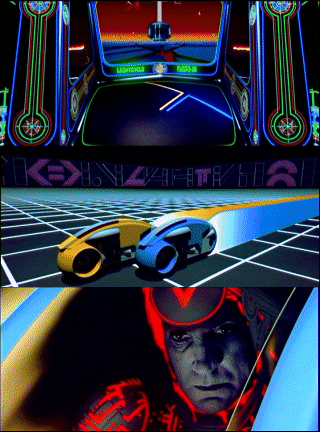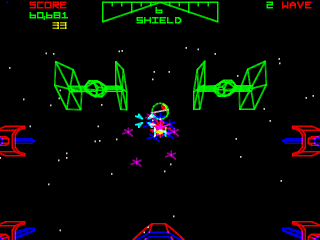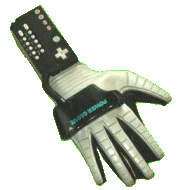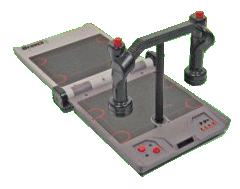TRON And The Birth Of Virtual
Reality
(NOTE: This article was originally written
during the early years of Vic George's Imaginarium, back when it was hosted by
Exit3.com. Its views reflect the gaming industry up to that particular
point in time. For the most part, I'm leaving this article without any
updated commentary.)
The idea of actually being inside a
videogame instead of just looking at a screen playing it has sparked the
imaginations of many gamers and even talented writers. Back when videogames were
introduced, the idea of using a television to manipulate onscreen objects and
even interact with other people was in itself a novelty. Not many people owned
game systems until the Atari 2600 made itself a household, and very few people
at the time could even afford personal computer systems. In addition, the
graphics of the early 1980s videogames were so simplistic, people actually had
to use their imaginations to see the onscreen objects as what the game designers
made them out to be and not just a bunch of randomly-placed pixels. To really be
part of the game, players had to mentally transfer themselves into the gaming
situation at hand.
 Walt Disney's 1982 science-fiction movie
Tron gave us a new way of how to look at videogaming. In the first
opening scene where somebody puts in a quarter and plays the "light cycle" game,
we see two beams of light streaking around on a video machine monitor. Then we
see a futuristic arena where an actual game of "light cycles" (high-powered
motorcycle-type vehicles that generate energy walls) take place, supposedly
mimicking the action of the video screen. Two actual people, or rather Game
Warriors as the movie calls them, are trying to make the other person crash into
his energy walls. When one of the Game Warriors finally crashes his bike, he
loses his "life" in the arena, but outside that area, the player who was
controlling him only lost a quarter! Later on, a game programmer named Flynn
(played by Jeff Bridges) finds himself in total awe tempered with a bit of fear
when the megalomaniacal Master Control Program digitizes him into that same
world, seeing the very videogames he designed brought to life in a way he only
wished he could develop them.
Walt Disney's 1982 science-fiction movie
Tron gave us a new way of how to look at videogaming. In the first
opening scene where somebody puts in a quarter and plays the "light cycle" game,
we see two beams of light streaking around on a video machine monitor. Then we
see a futuristic arena where an actual game of "light cycles" (high-powered
motorcycle-type vehicles that generate energy walls) take place, supposedly
mimicking the action of the video screen. Two actual people, or rather Game
Warriors as the movie calls them, are trying to make the other person crash into
his energy walls. When one of the Game Warriors finally crashes his bike, he
loses his "life" in the arena, but outside that area, the player who was
controlling him only lost a quarter! Later on, a game programmer named Flynn
(played by Jeff Bridges) finds himself in total awe tempered with a bit of fear
when the megalomaniacal Master Control Program digitizes him into that same
world, seeing the very videogames he designed brought to life in a way he only
wished he could develop them.
Tron gave us
our first glimpse into what would eventually be called "virtual reality", an
artificial world created by programmers that casual people could step into as
easily as stepping into another room. What that meant in the aspect of games is
that players could really feel like they're exploring a wonderful new world,
finding important treasures, facing dangers, and solving puzzles that are as
very bit real and tangible as what we experience in the real world. Of course,
what worked for a movie back then doesn't easily translate into what could work
for an actual videogame back in the early 1980s, but that didn't stop game
designers from trying. Immersion was the wave of the future, and they wanted to
make the products that would ride that wave.
 First of all, games had to make realistic
3D graphics that moved very fast and very convincingly. That wasn't a problem
for arcade games that used vector-scan displays like Star Wars and
Battlezone, since the monitors were specifically designed for the fast
go-anywhere redraws that vector-scan images required. But what those games
lacked were the feeling of textural substance -- everything looked like
transparent wire-frame objects with only a vague semblance of being 3D. Games
that used the traditional raster-scan technology of television were limited to
displaying "sprites", 2D objects that needed to be rescaled and redrawn to give
players a sense of 3D. It took the emergence of games that used polygon-built
characters to even begin making anything look and move like in a real universe.
The likes of Hard Drivin' and Virtua Fighter in the early 1990s
eventually paved the way for smoother and more texturally-enhanced 3D-animated
images to appear in the games that followed.
First of all, games had to make realistic
3D graphics that moved very fast and very convincingly. That wasn't a problem
for arcade games that used vector-scan displays like Star Wars and
Battlezone, since the monitors were specifically designed for the fast
go-anywhere redraws that vector-scan images required. But what those games
lacked were the feeling of textural substance -- everything looked like
transparent wire-frame objects with only a vague semblance of being 3D. Games
that used the traditional raster-scan technology of television were limited to
displaying "sprites", 2D objects that needed to be rescaled and redrawn to give
players a sense of 3D. It took the emergence of games that used polygon-built
characters to even begin making anything look and move like in a real universe.
The likes of Hard Drivin' and Virtua Fighter in the early 1990s
eventually paved the way for smoother and more texturally-enhanced 3D-animated
images to appear in the games that followed.

 Next came how the player would be able to
physically affect everything that goes on in the new world they have entered.
Merely using a joystick or gamepad to do that wasn't enough -- people had to use
their whole bodies, or at least other parts besides their fingers. The Amiga
Corporation, before they got involved with Commodore in developing the Amiga
computer system, brought forth the Joyboard controller for the Atari 2600, where
standing on the thing and shifting it this way and that with your feet was the
way to move yourself around on the video screen. Atari Corporation developed a
prototype controller called the Mindlink that was supposed to use your forehead
muscles to manipulate a paddle in a game called Bionic Breakthrough.
Broderbund and Mattel produced alternate types of "hand controllers" such as the
U-Force and the Power Glove for the original Nintendo system, which worked best
with the boxing game Punchout. And of course, there were also attempts to
develop headset goggles to bring the world of 3D gaming to the players' eyes.
Next came how the player would be able to
physically affect everything that goes on in the new world they have entered.
Merely using a joystick or gamepad to do that wasn't enough -- people had to use
their whole bodies, or at least other parts besides their fingers. The Amiga
Corporation, before they got involved with Commodore in developing the Amiga
computer system, brought forth the Joyboard controller for the Atari 2600, where
standing on the thing and shifting it this way and that with your feet was the
way to move yourself around on the video screen. Atari Corporation developed a
prototype controller called the Mindlink that was supposed to use your forehead
muscles to manipulate a paddle in a game called Bionic Breakthrough.
Broderbund and Mattel produced alternate types of "hand controllers" such as the
U-Force and the Power Glove for the original Nintendo system, which worked best
with the boxing game Punchout. And of course, there were also attempts to
develop headset goggles to bring the world of 3D gaming to the players' eyes.
 Sound has usually been overlooked when it
comes to producing games, but there was one thing developed in an attempt to
bring forth 3D sound effects. It was called QSound, and it came out in late 1990
with the release of Madonna's The Immaculate Collection, showcasing
various effects with spatial sound such as rotating synthesizers, thunderstorms,
and even voice bites. What QSound is supposed to be is the effect of
quadraphonic sound done through stereo speakers. Unfortunately, very few games
if ever were made featuring QSound, and those that did barely made much of an
immersion effect.
Sound has usually been overlooked when it
comes to producing games, but there was one thing developed in an attempt to
bring forth 3D sound effects. It was called QSound, and it came out in late 1990
with the release of Madonna's The Immaculate Collection, showcasing
various effects with spatial sound such as rotating synthesizers, thunderstorms,
and even voice bites. What QSound is supposed to be is the effect of
quadraphonic sound done through stereo speakers. Unfortunately, very few games
if ever were made featuring QSound, and those that did barely made much of an
immersion effect.
Overall, though, the idea of producing
such an immersive gaming experience similar to that of Tron (or for those
of the current younger generation, to that of the HoloDeck from the current
Star Trek TV series) is slowly shaping itself into reality. The games are
getting better looking and playing, plus the controls are also improving the
feel (including tactile feedback technology such as the Rumble Pak for the
Nintendo 64 and the Dual Shock for the PlayStation). But one can only wonder how
long it would be before playing a brand new videogame would mean being
transported into a whole new world that's so real and yet so unlike anything
you've experienced before.
 Walt Disney's 1982 science-fiction movie
Tron gave us a new way of how to look at videogaming. In the first
opening scene where somebody puts in a quarter and plays the "light cycle" game,
we see two beams of light streaking around on a video machine monitor. Then we
see a futuristic arena where an actual game of "light cycles" (high-powered
motorcycle-type vehicles that generate energy walls) take place, supposedly
mimicking the action of the video screen. Two actual people, or rather Game
Warriors as the movie calls them, are trying to make the other person crash into
his energy walls. When one of the Game Warriors finally crashes his bike, he
loses his "life" in the arena, but outside that area, the player who was
controlling him only lost a quarter! Later on, a game programmer named Flynn
(played by Jeff Bridges) finds himself in total awe tempered with a bit of fear
when the megalomaniacal Master Control Program digitizes him into that same
world, seeing the very videogames he designed brought to life in a way he only
wished he could develop them.
Walt Disney's 1982 science-fiction movie
Tron gave us a new way of how to look at videogaming. In the first
opening scene where somebody puts in a quarter and plays the "light cycle" game,
we see two beams of light streaking around on a video machine monitor. Then we
see a futuristic arena where an actual game of "light cycles" (high-powered
motorcycle-type vehicles that generate energy walls) take place, supposedly
mimicking the action of the video screen. Two actual people, or rather Game
Warriors as the movie calls them, are trying to make the other person crash into
his energy walls. When one of the Game Warriors finally crashes his bike, he
loses his "life" in the arena, but outside that area, the player who was
controlling him only lost a quarter! Later on, a game programmer named Flynn
(played by Jeff Bridges) finds himself in total awe tempered with a bit of fear
when the megalomaniacal Master Control Program digitizes him into that same
world, seeing the very videogames he designed brought to life in a way he only
wished he could develop them. First of all, games had to make realistic
3D graphics that moved very fast and very convincingly. That wasn't a problem
for arcade games that used vector-scan displays like Star Wars and
Battlezone, since the monitors were specifically designed for the fast
go-anywhere redraws that vector-scan images required. But what those games
lacked were the feeling of textural substance -- everything looked like
transparent wire-frame objects with only a vague semblance of being 3D. Games
that used the traditional raster-scan technology of television were limited to
displaying "sprites", 2D objects that needed to be rescaled and redrawn to give
players a sense of 3D. It took the emergence of games that used polygon-built
characters to even begin making anything look and move like in a real universe.
The likes of Hard Drivin' and Virtua Fighter in the early 1990s
eventually paved the way for smoother and more texturally-enhanced 3D-animated
images to appear in the games that followed.
First of all, games had to make realistic
3D graphics that moved very fast and very convincingly. That wasn't a problem
for arcade games that used vector-scan displays like Star Wars and
Battlezone, since the monitors were specifically designed for the fast
go-anywhere redraws that vector-scan images required. But what those games
lacked were the feeling of textural substance -- everything looked like
transparent wire-frame objects with only a vague semblance of being 3D. Games
that used the traditional raster-scan technology of television were limited to
displaying "sprites", 2D objects that needed to be rescaled and redrawn to give
players a sense of 3D. It took the emergence of games that used polygon-built
characters to even begin making anything look and move like in a real universe.
The likes of Hard Drivin' and Virtua Fighter in the early 1990s
eventually paved the way for smoother and more texturally-enhanced 3D-animated
images to appear in the games that followed.
 Next came how the player would be able to
physically affect everything that goes on in the new world they have entered.
Merely using a joystick or gamepad to do that wasn't enough -- people had to use
their whole bodies, or at least other parts besides their fingers. The Amiga
Corporation, before they got involved with Commodore in developing the Amiga
computer system, brought forth the Joyboard controller for the Atari 2600, where
standing on the thing and shifting it this way and that with your feet was the
way to move yourself around on the video screen. Atari Corporation developed a
prototype controller called the Mindlink that was supposed to use your forehead
muscles to manipulate a paddle in a game called Bionic Breakthrough.
Broderbund and Mattel produced alternate types of "hand controllers" such as the
U-Force and the Power Glove for the original Nintendo system, which worked best
with the boxing game Punchout. And of course, there were also attempts to
develop headset goggles to bring the world of 3D gaming to the players' eyes.
Next came how the player would be able to
physically affect everything that goes on in the new world they have entered.
Merely using a joystick or gamepad to do that wasn't enough -- people had to use
their whole bodies, or at least other parts besides their fingers. The Amiga
Corporation, before they got involved with Commodore in developing the Amiga
computer system, brought forth the Joyboard controller for the Atari 2600, where
standing on the thing and shifting it this way and that with your feet was the
way to move yourself around on the video screen. Atari Corporation developed a
prototype controller called the Mindlink that was supposed to use your forehead
muscles to manipulate a paddle in a game called Bionic Breakthrough.
Broderbund and Mattel produced alternate types of "hand controllers" such as the
U-Force and the Power Glove for the original Nintendo system, which worked best
with the boxing game Punchout. And of course, there were also attempts to
develop headset goggles to bring the world of 3D gaming to the players' eyes. Sound has usually been overlooked when it
comes to producing games, but there was one thing developed in an attempt to
bring forth 3D sound effects. It was called QSound, and it came out in late 1990
with the release of Madonna's The Immaculate Collection, showcasing
various effects with spatial sound such as rotating synthesizers, thunderstorms,
and even voice bites. What QSound is supposed to be is the effect of
quadraphonic sound done through stereo speakers. Unfortunately, very few games
if ever were made featuring QSound, and those that did barely made much of an
immersion effect.
Sound has usually been overlooked when it
comes to producing games, but there was one thing developed in an attempt to
bring forth 3D sound effects. It was called QSound, and it came out in late 1990
with the release of Madonna's The Immaculate Collection, showcasing
various effects with spatial sound such as rotating synthesizers, thunderstorms,
and even voice bites. What QSound is supposed to be is the effect of
quadraphonic sound done through stereo speakers. Unfortunately, very few games
if ever were made featuring QSound, and those that did barely made much of an
immersion effect.